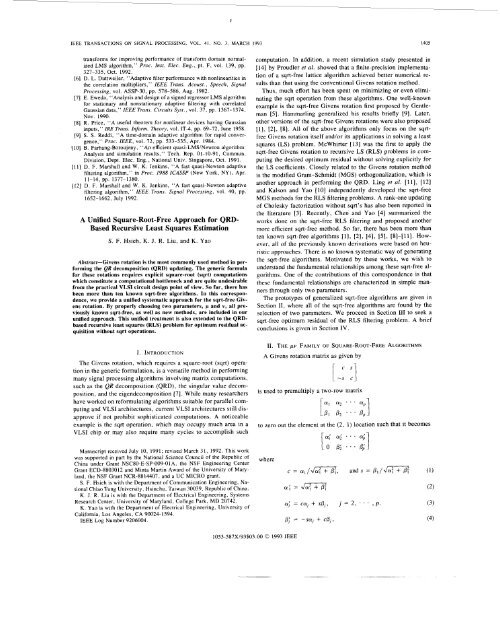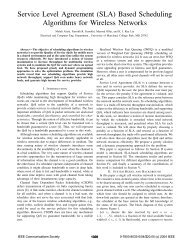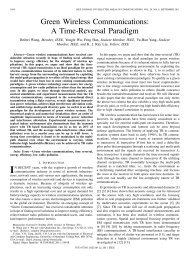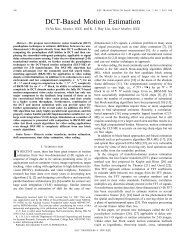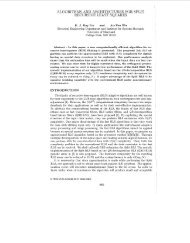A unified square-root-free approach for QRD-based recursive-least ...
A unified square-root-free approach for QRD-based recursive-least ...
A unified square-root-free approach for QRD-based recursive-least ...
Create successful ePaper yourself
Turn your PDF publications into a flip-book with our unique Google optimized e-Paper software.
IEEE TRANSACTIONS ON SIGNAL PROCESSING. VOL. 41. NO. 3. MARCH 1993 1405<br />
trans<strong>for</strong>ms <strong>for</strong> improving per<strong>for</strong>mance of trans<strong>for</strong>m domain normalized<br />
LMS algorithm,” Proc. Inst. Elec. Eng., pt. F, vol. 139, pp.<br />
327-335, Oct. 1992.<br />
[6] D. L. Duttweiler, “Adaptive filter per<strong>for</strong>mance with nonlinearities in<br />
the correlation multipliers,” IEEE Trans. Acoust. , Speech, Signal<br />
Processing, vol. ASSP-30, pp. 578-586, Aug. 1982.<br />
[7] E. Eweda, “Analysis and design of a signed regressor LMS algorithm<br />
<strong>for</strong> stationary and nonstationary adaptive filtering with correlated<br />
Gaussian data,” IEEE Trans. Circuits Syst., vol. 37, pp. 1367-1374,<br />
Nov. 1990.<br />
[8] R. Price, “A useful theorem <strong>for</strong> nonlinear devices having Gaussian<br />
inputs,” IRE Trans. Infarm. Theory, vol. IT-4, pp. 69-72, June 1958.<br />
[9] S. S. Reddi, “A time-domain adaptive algorithm <strong>for</strong> rapid convergence,”<br />
Proc. IEEE, vol. 72, pp. 533-535, Apr. 1984.<br />
[lo] B. Farhang-Boroujeny, “An efficient quasi-LMSiNewton algorithm:<br />
Analysis and simulation results,’’ Tech. Rep. 01-10-91, Commun.<br />
Division, Dept. Elec. Eng., National Univ. Singapore, Oct. 1991.<br />
1111 D. F. Marshall and W. K. Jenkins, “A fast quasi-Newton adaptive<br />
filtering algorithm,” in Proc. 1988 ICASSP (New York, NY), Apr.<br />
11-14, pp. 1377-1380.<br />
[I21 D. F. Marshall and W. K. Jenkins, “A fast quasi-Newton adaptive<br />
filtering algorithm,” IEEE Trans. Signal Processing, vol. 40, pp.<br />
1652-1662, July 1992.<br />
A Unified Square-Root-Free Approach <strong>for</strong> <strong>QRD</strong>-<br />
Based Recursive Least Squares Estimation<br />
S. F. Hsieh, K. J. R. Liu, and K. Yao<br />
Abstract-Givens rotation is the most commonly used method in per<strong>for</strong>ming<br />
the QR decomposition (<strong>QRD</strong>) updating. The generic <strong>for</strong>mula<br />
<strong>for</strong> these rotations requires explicit <strong>square</strong>-<strong>root</strong> (sqrt) computations<br />
which constitute a computational bottleneck and are quite undesirable<br />
from the practical VLSI circuit design point of view. So far, there has<br />
been more than ten known sqrt-<strong>free</strong> algorithms. In this correspondence,<br />
we provide a <strong>unified</strong> systematic <strong>approach</strong> <strong>for</strong> the sqrt-<strong>free</strong> Givens<br />
rotation. By properly choosing two parameters, p and v, all previously<br />
known sqrt-<strong>free</strong>, as well as new methods, are included in our<br />
<strong>unified</strong> <strong>approach</strong>. This <strong>unified</strong> treatment is also extended to the <strong>QRD</strong><strong>based</strong><br />
<strong>recursive</strong> <strong>least</strong> <strong>square</strong>s (RLS) problem <strong>for</strong> optimum residual acquisition<br />
without sqrt operations.<br />
I. INTRODUCTION<br />
The Givens rotation, which requires a <strong>square</strong>-<strong>root</strong> (sqrt) operation<br />
in the generic <strong>for</strong>mulation, is a versatile method in per<strong>for</strong>ming<br />
many signal processing algorithms involving matrix computations,<br />
such as the QR decomposition (<strong>QRD</strong>), the singular value decomposition,<br />
and the eigendecomposition [7]. While many researchers<br />
have worked on re<strong>for</strong>mulating algorithms suitable <strong>for</strong> parallel computing<br />
and VLSI architectures, current VLSI architectures still disapprove<br />
if not prohibit sophisticated computations. A noticeable<br />
example is the sqrt operation, which may occupy much area in a<br />
VLSI chip or may also require many cycles to accomplish such<br />
computation. In addition, a recent simulation study presented in<br />
[ 141 by Proudler et al. showed that a finite-precision implementation<br />
of a sqrt-<strong>free</strong> lattice algorithm achieved better numerical results<br />
than that using the conventional Givens rotation method.<br />
Thus, much ef<strong>for</strong>t has been spent on minimizing or everl eliminating<br />
the sqrt operation from these algorithms. One well-known<br />
example is the sqrt-<strong>free</strong> Givens rotation first proposed by Gentleman<br />
[5]. Hammarling generalized his results briefly [9]. Later,<br />
other versions of the sqrt-<strong>free</strong> Givens rotations were also proposed<br />
[l], [2], [8]. All of the above algorithms only focus on the sqrt<strong>free</strong><br />
Givens rotation itself andlor its applications in solving a <strong>least</strong><br />
<strong>square</strong>s (LS) problem. McWhirter (131 was the first to apply the<br />
sqrt-<strong>free</strong> Givens rotation to <strong>recursive</strong> LS (RLS) problems in computing<br />
the desired optimum residual without solving explicitly <strong>for</strong><br />
the LS coefficients. Closely related to the Givens rotation method<br />
is the modified Gram-Schmidt (MGS) orthogonalization, which is<br />
another <strong>approach</strong> in per<strong>for</strong>ming the <strong>QRD</strong>. Ling et al. [ll], 1121<br />
and Kalson and Yao [lo] independently developed the sqrt-<strong>free</strong><br />
MGS methods <strong>for</strong> the RLS filtering problems. A rank-one updating<br />
of Cholesky factorization without sqrt’s has also been reported in<br />
the literature 131. Recently, Chen and Yao [4] summarized the<br />
works done on the sqrt-<strong>free</strong> RLS filtering and proposed another<br />
more efficient sqrt-<strong>free</strong> method. So far, there has been more than<br />
ten known sqrt-<strong>free</strong> algorithms 111, [2], [4], 151, [8]-[ll]. However,<br />
all of the previously known derivations were <strong>based</strong> on heuristic<br />
<strong>approach</strong>es. There is no known systematic way of generating<br />
the sqrt-<strong>free</strong> algorithms. Motivated by these works, we wish to<br />
understand the fundamental relationships among these sqrt-<strong>free</strong> algorithms.<br />
One of the contributions of this correspondence is that<br />
these fundamental relationships are characterized in simple manners<br />
through only two parameters.<br />
The prototypes of generalized sqrt-<strong>free</strong> algorithms are given in<br />
Section 11, where all of the sqrt-<strong>free</strong> algorithms are found by the<br />
selection of two parameters. We proceed in Section I11 to seek a<br />
sqrt-<strong>free</strong> optimum residual of the RLS filtering problem. A brief<br />
conclusions is given in Section IV.<br />
11. THE pv FAMILY OF SQUARE-ROOT-FREE ALGORITHMS<br />
A Givens rotation matrix as given by<br />
is used to premultiply a two-row matrix<br />
CY1<br />
CY2...ap<br />
PI 02 - . . 0,<br />
to zero out the element at the (2, I) location such that it becomes<br />
a; ff; . . . ff;<br />
1<br />
Manuscript received July 10, 1991; revised March 31, 1992. This work<br />
was supported in pan by the National Science Council of the Republic of<br />
China under Grant NSC80-E-SP-009-01 A, the NSF Engineering Center<br />
Grant ECD-8803012 and Minta Martin Award of the University of Maryland,<br />
the NSF Grant NCR-8814407, and a UC MICRO grant.<br />
S. F. Hsieh is with the Department of Communication Engineering, National<br />
Chiao Tung University, Hsinchu, Taiwan 30039, Republic of China.<br />
K. J. R. Liu is with the Department of Electrical Engineering, Systems<br />
Research Center, University of Maryland, College Park, MD 20742.<br />
K. Yao is with the Department of Electrical Engineering, University of<br />
Cali<strong>for</strong>nia, Los Angeles, CA 90024- 1594.<br />
IEEE Log Number 9206004.<br />
where<br />
c = a,/-, ands = PI/- (1)<br />
1053-587X/93$03.00 0 1993 IEEE
I<br />
I406 IEEE rRANSACTIONS ON SIGNAL PROCESSING, VOL. 41, NO. 3. MARCH 1993<br />
In VLSI circuit design, sqrt operation is expensive, because it<br />
takes up much area or is slow (due to many iterations). There<strong>for</strong>e,<br />
it is advantageous to avoid or minimize sqrt operations.<br />
By taking out a scaling factor from each row, the two rows under<br />
consideration be<strong>for</strong>e and after the Givens orthogonal trans<strong>for</strong>mations<br />
is denoted by<br />
and<br />
where<br />
,, kh, k6, and kA are the scaling factors resulting in sqrt-<strong>free</strong> - .<br />
operations, and a: and p: are the updated a, and 0, when PI is<br />
zeroed out.<br />
Now, our task is to find the expressions <strong>for</strong>, k:, ki, a;, {(a,’,<br />
b,’), j = 2. . . . , p}, in terms of k,, kh, {(a,, bl),j = 1, . . . ,p},<br />
such that no sqrt operation is actually needed. The sqrt expressions<br />
and 4 in (5) and (6) are used <strong>for</strong> representa-<br />
of a, a, 4.<br />
tional purposes only and are not actually per<strong>for</strong>med.<br />
Replacing a, = &a,, 0, = a b,, ai = &U,’, 6; = &b,’, j<br />
= 1, . . . , p, in (1)-(4) leads to<br />
(6)<br />
s expressions in (18) are not explicitly needed in the computation<br />
of (l3)-(17). The use of the rotation parameter c in (18) (with one<br />
sqrt operation) will be further considered in Section I11 when the<br />
optimum residual e is desired. Furthermore, Section 111 will show<br />
that it is possible to obtain e without any sqrt operation and the<br />
explicit computation of the rotation parameter c can be bypassed.<br />
To avoid repetitive computations and take the advantage of previously<br />
computed results, (14). (16), and (18) use the newly updated<br />
k: of (13). As stated earlier, we are <strong>free</strong> to choose those two parameters<br />
p and U. Different choices of p and U will affect the number<br />
of multiplications and divisions, as well as the numerical stability<br />
and parallelism of these computations.<br />
It can be easily shown that this <strong>unified</strong> view can generate all of<br />
the previously known sqrt-<strong>free</strong> algorithms via a proper choice of p<br />
and U. In fact, there has been more than ten sqrt-<strong>free</strong> algorithms<br />
known so far. Among them are Gentleman [5], Hammarling [9],<br />
Bareiss [I], Kalson and Yao [IO], Ling er al. [Ill, [12], Barlow<br />
and Ispen [2], Chen and Yao 141, Gotze and Schwiegelsohn [8].<br />
For example, if we choose p = 1 and U = 1, it becomes the sqrt<strong>free</strong><br />
algorithm proposed by Gentleman in [5] and can be updated<br />
as follows:<br />
k6 = k,,a: + k,bt (19)<br />
ki, = k,,ki,/kA (20)<br />
a; = 1 (21)<br />
a; = J(k,at + kbbt)/kL<br />
a,’ = (k,a,a, +khb1b,)/kl,<br />
b,’ = -bla, + a,b,.<br />
j = 2, . . . . P<br />
1<br />
a; = [koala, + kbblb,] j = 2, . . . 3 P. To check that these results are correct, we find that<br />
4 Jk,a: + kbb:<br />
To avoid sqrt computation, we need to determine k: and ki such<br />
that ai, a,’, and b,’ will not require sqrt operation. It is clear that if<br />
we choose k,!, and ki as<br />
and<br />
a; = 4 a ; =<br />
-<br />
kuala]<br />
+ khblb,<br />
4<br />
ala, + PIP,<br />
= c,a/ + SIP]<br />
m<br />
(22)<br />
ku kb<br />
k’ - v2(k,a: + kbb:) .IO, - Pia, -<br />
- - -sa, + cp,<br />
(24)<br />
where p and U are parameters that will be determined later to be<br />
any sqrt-<strong>free</strong> function of k,, kb, a,, and b,, then @-(IO) can be<br />
which are consistent with the results in (3) and (4). For the systolic<br />
computed without sqrt operation. We then have the following uparray<br />
implementation described in [13], we choose a, = 1 and dedating<br />
<strong>for</strong>mulas without sqrt operation:<br />
fine the generalized rotational parameters<br />
k: = (koa: + kbb:)/p2 (13)<br />
Then we have<br />
C = k,/k‘:, and S = k,b,/k,!,. (25)<br />
a,’ = Cu, + Sb,<br />
b,’ = b, - bla,.<br />
(27)<br />
(28)<br />
b,’ = u[-b,a, + a,b,] (17)<br />
c = (al/p)a, and s = (b,/p)Jkh/k:,. (18)<br />
Notice that the sqrt operations disappear in our <strong>for</strong>mulas of (13)-<br />
(17), while they are needed in the Givens rotations. Also, the c and<br />
These results are consistent with the works by Gentleman [5] and<br />
McWhirter [ 131. The details of the systolic implementation can be<br />
found in [13].<br />
In Table I, we list various sqrt-<strong>free</strong> algorithms and the corresponding<br />
choices of p and U. Hence, this class of sqrt-<strong>free</strong> algo-
IEEE TRANSACTIONS ON SIGNAL PROCESSING, VOL. 41, NO. 3, MARCH 1993<br />
I407<br />
TABLE I<br />
SOME KNOWN SQRT-FREE ALGORITHMS OF THE pv FAMILY<br />
Ir V Authors (Year) Remark<br />
1<br />
Gentleman (1973) a, = 1<br />
Hammarling (1974)<br />
1<br />
a, + k,b:<br />
Bareiss (1982)<br />
Ling (1989), KalsoniYao (1985) k,,a, = 1<br />
CheniYao (1988) k,a, = 1<br />
1<br />
GotzeiSchwiegelshohn (1989)<br />
BarlowiIspen (1 987)<br />
Scaled<br />
New algorithm<br />
~-<br />
TABLE I1<br />
COMPARISONS OF COMPUTATIONAL COMPLEXITY OF SOME MEMBERS IN +V FAMILY<br />
Multiplication Division Addition<br />
Square Root<br />
Givens Rotation<br />
4P<br />
1 2p - 1 1<br />
p = l , u = l 4p + 3 1 2p - 1 0<br />
2p + 6 2 2p - 1 0<br />
2p + 6 2 2p - 1 0<br />
1<br />
p = l , v = -<br />
a,<br />
4p + 4 2 2p - 1 0<br />
4p + 5 1 2p - 2 0<br />
Cc=-<br />
koa: + khb: , u = 1 4p + 6 2 2p - 1 0<br />
ko kh<br />
1<br />
p = koa: + k,b:, v =<br />
koa: + khb:<br />
4p + 4 1 2p - 1 0<br />
rithms is called the pv family of sqrt-<strong>free</strong> Givens rotation algo- 1<br />
rithms.<br />
v =<br />
koa: + kbb:<br />
not Only can we generate those known sqrt-<strong>free</strong> algothen<br />
we can readily verify that this is a new sqrt-<strong>free</strong> algorithm. In<br />
flthms, but we are to find new sqrt-<strong>free</strong><br />
by fact, the new sqfl-<strong>free</strong> algorithm is among the best in the list of<br />
choosing new pairs Of (p, ’) parameters. an let us<br />
Table I in terms of number of divisions, e.g., it only requires one<br />
choose<br />
division and no <strong>square</strong> <strong>root</strong>. In principle, there are unlimited choices<br />
of p and v <strong>for</strong> sqrt-<strong>free</strong> algorithms. Table I1 shows comparisons of<br />
p = koa: + kbb:<br />
computational complexity of some algorithms listed in Table I.
1408 IEEE TRANSACTIONS ON SIGNAL PROCESSING, VOL. 41, NO. 3, MARCH 1993<br />
111. SQRT-FREE TRIANGULAR ARRAY UPDATING AND OPTIMUM<br />
RESIDUAL ACQUISITION<br />
Solving a full rank LS problem Aw = b (A E RmXn, m 2 n)<br />
without the sqrt operation can be easily achieved [5]. Let the <strong>QRD</strong><br />
of A be QTA = R, where R is an upper triangular matrix, then<br />
(34)<br />
and the optimum weight vector can be obtained by solving RO =<br />
U. Now, starting with a full dense augmented matrix &[A b], a<br />
series of sqrt-<strong>free</strong> rotations can be applied to zero out the subvector<br />
below the main diagonal of the underlying matrix to obtain<br />
&[R 0 ; 61<br />
where & = diag (4, . ' ' , 4)<br />
and R = &SF, U = &U.<br />
Since the explicit computation of & is not required, the optimum<br />
weight vector can be obtained without the sqrt operation by<br />
solving RO = U.<br />
In the following, we will apply the developed prototypes of sqrt<strong>free</strong><br />
rotations developed be<strong>for</strong>e to the <strong>QRD</strong>-<strong>based</strong> RLS estimation<br />
problem where we are only interested in the optimum residual. How<br />
to obtain the optimum residual by using the systolic array [ 131 has<br />
been well known. To be specific, we are interested in updating<br />
from<br />
R u R' U'<br />
L T to [o' v 1. (30)<br />
with (pl, vI) being the parameter pair which are still <strong>free</strong> to be<br />
chosen later. Note the close analogy of (33)-(38) to those of (13)-<br />
(18). Similarly, after the ith rotation (1 < i i p), we have<br />
k,' =<br />
k,u2 + k(1-I)bll-I)'<br />
11 4<br />
PLf<br />
(39)<br />
(42)<br />
(43)<br />
It has been shown [13] that the p X p upper triangular matrix R'<br />
can be obtained through a sequence of p Givens rotations, and the<br />
optimum residual e <strong>for</strong> the newly appended data [x' y] is given<br />
by<br />
with c, representing the cosine value of the i th rotation angle.<br />
Factoring out the scaling constants into the premultiplying diagonal<br />
matrix leads (30) to the <strong>for</strong>m of<br />
Finally, after p rotations are finished, (32) becomes<br />
ai2 . . . a;,,<br />
a& . . . ai,<br />
.. .<br />
4,<br />
0 ... 0<br />
(44)<br />
which has the <strong>for</strong>m of<br />
I:; 3<br />
in (30). The optimum residual e in (31) now becomes<br />
-<br />
where kbp' is defined in (40). To further simplify the expression in<br />
(46), we notice that k) can be computed <strong>recursive</strong>ly as follows:<br />
Unlike the previously developed <strong>for</strong>mula, where we are only interested<br />
in updating k,, a,, , to k,' , U,', and zeroing out all the b,'s,<br />
this time we also need to know the cosine values explicitly as required<br />
in the optimum residual given in (31).<br />
After the first rotation, b, will be zeroed out and we have<br />
(33)<br />
where (40) is used in the recursion
I<br />
IEEE TRANSACTIONS ON SIGNAL PROCESSING, VOL. 41. NO. 3, MARCH 1993<br />
I409<br />
With (49) substituted into (46), we have<br />
Because & [b,, bZ, . . . , bp, b,,+ ,] = [xi, x2, . . . , x,,, y] is the<br />
appended new data row, we are certainly <strong>free</strong> to choose k, = 1 to<br />
reduce the arithmetic complexity and simplify the expression in<br />
(SO). There<strong>for</strong>e, a lemma on obtaining the sqrt-<strong>free</strong> optimum residual<br />
is given below.<br />
Lemma 1: (Sqrt-<strong>free</strong> Optimum Residual): The optimum residual<br />
e can be computed with no sqrt operations and is given by<br />
if k, is chosen to be unity. 0<br />
McWhirter [ 131 successfully employed Gentleman’s proposition<br />
[5] in computing the residual e without sqrt operations. By choosing<br />
p, = v, = a,, = I, 1 C- i 5 p , the optimum residual can be<br />
reduced to<br />
(Gentleman/McWhirter) (52)<br />
where C, is defined in (2.5). This result is again consistent with the<br />
work by McWhirter [ 131.<br />
Another example can be taken from Hammarling’s suggestion<br />
[9] as follows:<br />
Then it follows that k: = k,a,,/p, and the Hammarling optimum<br />
residual is given by<br />
REFERENCES<br />
[I] E. H. Bareiss, “Numerical solution of the weighted <strong>least</strong> <strong>square</strong>s<br />
problems by G-trans<strong>for</strong>mations,” Tech. Rep. 82-03-NAM-03, Dep.<br />
Elec. Eng. Comput. Sci., Northwestem University, Evanston, IL,<br />
Apr. 1982.<br />
[2] J. L. Barlow and I. C. F. Ipsen, “Scaled Givens rotations <strong>for</strong> the<br />
solution of linear <strong>least</strong> <strong>square</strong>s problems on systolic arrays,” SIAM<br />
J. Sci. Stat. Compur., vol. 8, no. 5, pp. 716-733, Sept. 1987.<br />
[3] G. J. Bier”, Factorizntion Methods <strong>for</strong> Discrefe Sequential Esrimation.<br />
New York: Academic, 1977, p. 44.<br />
[4] M. J. Chen and K. Yao, “Comparisons of QR <strong>least</strong> <strong>square</strong>s algorithms<br />
<strong>for</strong> systolic array processing,” in Proc. Conf. In<strong>for</strong>m. Sci.<br />
Syst., Mar. 1988, pp. 683-688.<br />
[5] W. M. Gentleman, “Least <strong>square</strong>s computations by Givens trans<strong>for</strong>mations<br />
without <strong>square</strong> <strong>root</strong>s,” J. Insf. Math. Appl., vol. 12, pp.<br />
329-336, 1973.<br />
[6] W. M. Gentleman and H. T. Kung, “Matrix triangularization by systolic<br />
arrays,” Proc. SPIE Int. Soc. Opt. Eng., vol. 298, pp. 19-26,<br />
1981.<br />
[7] G. H. Golub and C. F. Van Loan, Matrix Compurations, 2nd ed.<br />
Baltimore, MD: Johns Hopkins Press, 1989.<br />
[SI J. Gotze and U. Schwiegelshohn, “An orthogonal method <strong>for</strong> solving<br />
systems of linear equations without <strong>square</strong> <strong>root</strong>s and with few divisions,”<br />
in Proc. IEEE ICASSP, 1989, pp. 1298-1301.<br />
[9] S. Hammarling, “A note on modifications to the Givens plane rotation,”<br />
J. Inst. Mafh. Appl., vol. 13, pp. 215-218, 1974.<br />
IO] S. Kalson and K. Yao, “Systolic array processing <strong>for</strong> order and time<br />
<strong>recursive</strong> generalized <strong>least</strong> <strong>square</strong>s estimation,” Proc. SPIE Int. Soc.<br />
Opt. Eng., vol. 564, pp. 28-38, 1985.<br />
II] F. Ling, D. Manolakis, and J. G. Proakis, “A <strong>recursive</strong> modified<br />
Gram-Schmidt algorithm <strong>for</strong> <strong>least</strong> <strong>square</strong>s estimation,” IEEE Trans.<br />
Acoust., Speech, Signal Processing, vol. ASSP-34, no. 4, pp. 829-<br />
836, Aug. 1986.<br />
121 F. Ling, “Efficient <strong>least</strong> <strong>square</strong>s lattice algorithm <strong>based</strong> on Givens<br />
rotations with systolic array implementation,” in Proc. IEEE ICASSP,<br />
1989, pp. 1290-1293.<br />
1131 J. G. McWhirter, “Recursive <strong>least</strong> <strong>square</strong>s minimization using a systolic<br />
array,” Proc. SPIEInt. Soc. Opt. Eng., vol. 431, pp. 105-112,<br />
1983.<br />
1141 1. K. Proudler, J. G. McWhirter, and T. J. Shepherd, “The <strong>QRD</strong><strong>based</strong><br />
<strong>least</strong> <strong>square</strong>s lattice algorithm: Some computer simulations using<br />
finite wordlength,” in Proc. IEEE ISCAS, New Orleans, May<br />
1990, pp. 258-261.<br />
[I51 S. F. Hsieh, K. J. R. Liu, and K. Yao, “A <strong>unified</strong> sqrt-<strong>free</strong> rank-I<br />
upidowndating <strong>approach</strong> <strong>for</strong> <strong>recursive</strong> <strong>least</strong> <strong>square</strong>s problems,” in<br />
Proc. IEEE Int. Conf. Acoust., Speech, Signal Processing (ICASSP),<br />
Toronto, May 1991, pp. 1017-1020.<br />
Phase Retrieval Using a Window Function<br />
IV. CONCLUSIONS<br />
The Givens rotation is the most commonly used method in per<strong>for</strong>ming<br />
<strong>QRD</strong> updating. Most of these rotation-<strong>based</strong> methods require<br />
explicit sqrt computations which are undesirable from the<br />
practical VLSI circuit design point of view. Our work is the first<br />
ef<strong>for</strong>t to establish basic understanding of all known sqrt-<strong>free</strong> <strong>QRD</strong><br />
algorithms, from which the basic criterion is seen to be simple. We<br />
have shown that all the current known sqrt-<strong>free</strong> algorithms belong<br />
to the pv family. New sqrt-<strong>free</strong> algorithms can be easily obtained<br />
from this pv family. The issue of choosing optimal parameters /A<br />
and v in terms of computational complexity (hardware and software)<br />
and numerical properties still remains an open question. This<br />
<strong>unified</strong> <strong>approach</strong> also provides a fundamental framework <strong>for</strong> the<br />
sqrt-<strong>free</strong> RLS algorithm, which is essential <strong>for</strong> fast operations and<br />
practical VLSI implementations.<br />
Wooshik Kim and Monson H. Hayes<br />
Abstract-In this correspondence, we consider the problem of reconstructing<br />
a signal from the Fourier intensity of the signal and the Fourier<br />
intensities of two windowed signals: one by a window w (n) and the<br />
other by its complementary window [l - w(n)]. We develop several<br />
conditions under which a signal can be uniquely specified to within<br />
several trivial ambiguities such as sign, translation, and time reversal<br />
from the given conditions. We present a possible reconstruction algorithm<br />
derived from the Gerchberg-Saxton algorithm.<br />
Manuscript received February 5, 1992; revised August 6, 1992. This<br />
work was supported by the Joint Services Program under Contract DAAL-<br />
03 -90-C-OOO4.<br />
The authors are with the School of Electrical Engineering, Georgia Institute<br />
of Technology, Atlanta, GA 30332-0250.<br />
IEEE Log Number 9205997.<br />
1053-587X/93$03.00 0 1993 IEEE


